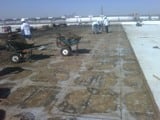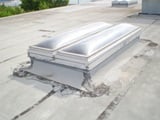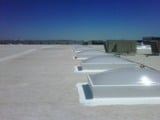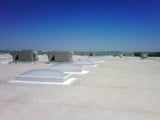Houston Food Bank: Ready to Serve Even More
The Houston Food Bank has been serving Harris and 17 other southeast Texas counties since 1982. At In their first year they delivered about one million pounds of food to community distribution programs. In 2010 the Food Bank dispersed 70 million pounds of food and fed 137,000 individuals each week through its charitable network of food pantries, shelters and nutrition programs. With an admirable goal of increasing its output to 120 million pounds of food annually by 2018, the Food Bank needed larger digs to help them reach their full potential.
The Food Bank purchased a warehouse facility from Sysco Foods, Inc. on the east side of Houston that fit the bill; it is four times larger than their previous location, and it has a warehouse area to prep and house dry goods as well as a massive refrigerator and freezer to store perishable items. The nonprofit organization made one of the biggest leaps in its history when they decided to buy this facility, and each dollar spent in its renovation is being maximized to its fullest. They chose a “guaranteed maximum price” project delivery method so that all cost savings could be given back to the organization’s cause.
General Contractor, Tellepsen Builders, selected Chamberlin as the roofing subcontractor for the 308,000 sq. ft. facility. “It was a no-brainer to hire Chamberlin for this project,” said Tellepsen Quality Coordinator Bob Dulovics. “Not only were they the low bidder, but they have the expertise and infrastructure to meet the demands of this challenging project.”
The integrity of the entire building envelope is a vital part of this food processing facility because of its large refrigerated areas and low tolerance for moisture intrusion. The existing roof systems atop the facility were a hodgepodge of EPDM, BUR and Modified Bitumen. Chamberlin’s task was to remove the roofs and replace them with reliable, energy efficient systems.

The 70,000 sq. ft. freezer and cooler spaces came with their own set of challenges. The potential for moisture formation around a cold storage unit in Houston’s hot, humid climate created a critical need to get the design right from the beginning to ensure airtight integrity. Chamberlin worked with the construction team to come up with design details to solve problems associated with the different internal temperatures of the large refrigerated coolers while considering moisture protection, energy efficiency and cost control.
“Chamberlin’s attention to detail, making sure edges were properly sealed to keep water and air out, was very important,” said Dulovics, “a lot of thought went into making a building envelope that looks and performs well.
The freezer had an EPDM black membrane system that was removed down to the metal deck, which was found to be rusting. The Chamberlin team painted and primed the deck with rust inhibitor and sealed all penetrations and perimeters with a vapor barrier to ensure its airtightness. Ten inches of insulation was adhered to the deck to the meet the required R-55 thermal resistance for the freezer and refrigerator. A white, reflective Carlisle TPO single-ply membrane capped off the system to reduce heat transference for further energy efficiency.

A large portion of the existing roof over the 200,000 sq. ft. dry good warehouse and truck facility had a Loadmaster-type deck, which can be tricky to work on during replacement. With a deck of this type, heavy materials or equipment on the roof could easily overload its capacity. So, Chamberlin was mindful to stage material and coordinate manpower to prevent any damage to the deck or injury to workers. The new roof system over the warehouse has a thermal resistance value of R-30 with five inches of roofing insulation. This is unusual because, by code, the Food Bank could have gone with an assembly as low as R-17, but chose to upgrade for the comfort of their volunteers who work in the warehouse each day.
Part of the warehouse roof was a good candidate for a TPO overlay with new insulation rather than a full removal and replacement, saving the Food Bank as much as $100,000 in additional expenses. Chamberlin also installed approximately 100 skylights and curbs over the warehouse and enclosed offices providing access to daylight and reducing the need for artificial lighting.
Though there were significant safety concerns on the roof with a large number of existing skylights to be removed and the Loadmaster carrying capacity, Chamberlin was experienced and detail oriented in preparing the safety plan.

Safety challenges were easily overcome by Chamberlin due to their safety-minded culture,” said Dulovics, “we didn’t have to worry about them because they are very professional about what they do.”
Fall protection hazards at the building perimeter and around skylights were identified and discussed in Chamberlin’s morning team meetings and regular site visits were performed by in-house safety inspectors.
The Houston Food Bank opened the doors of their new facility to donors and the community on September 23, 2011. On that day the warehouse was filled with over one million pounds of food donations.
"In its first quarter-century, Houston Food Bank has touched the lives of hundreds of thousands of individuals - men, women and children from all walks of life and income levels," says Brian Greene, president/CEO of Houston Food Bank, "but, sadly, we must continue to work harder. As the economy fluctuates and people find themselves without work or are unable to make ends meet, they are turning to organizations such as the Houston Food Bank for help, many for the first time ever. This incredible new facility lessens our restrictions so our reach can extend further to help those in need."
Subscribe Today!
Stay-in-the-know and subscribe to our blog today!